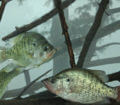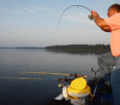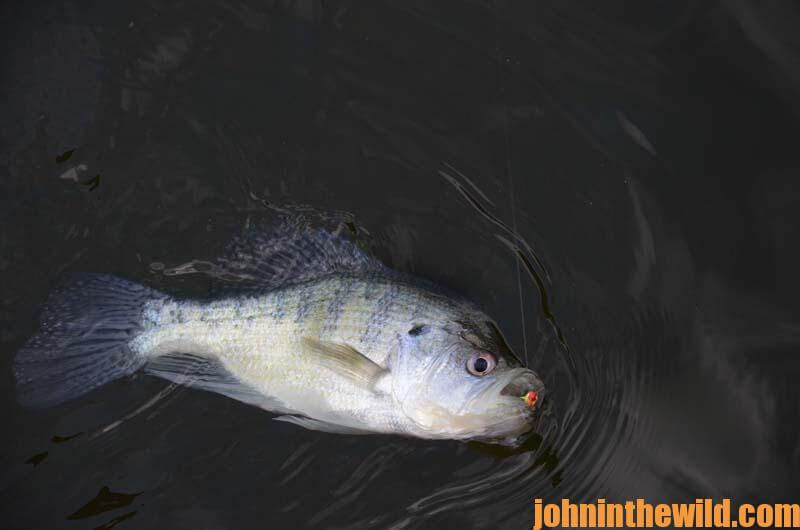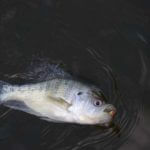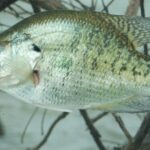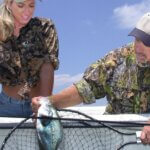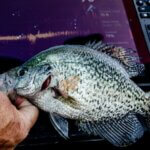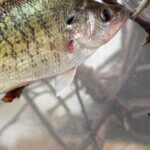Editor’s Note: My late friend, bass-fishing phenom Ken Cook of Meers, Oklahoma, won both a Bassmasters Classic Mega Bucks tournament. But before his bass-fishing fame, Cook was a fisheries biologist and loved to crappie fish. Cook gave me some great tips for catching crappie some years ago that produce summertime crappie today. I’ve also interviewed numbers of professional crappie anglers about their summertime tactics.
Fish Bridge Pilings and Railroad Trestles:
“Another area that provides cover in deep water along creek channels and river ledges is bridge pilings and railroad trestles that cross major creek and river channels,” Cook told me. “During the hot summer months, these vertical structures that go from the bottom to above the surface allow a crappie to hold in any depth of water in which it wants to hold. Plus if there’s current coming through the lake, the bridge pilings offer a current break where baitfish and crappie can hold. Fishing bridge pilings either by day or night can pay major crappie dividends for the summertime crappie angler.”
“Yet another tactic that anglers can use once they understand the three steps to finding crappie is what I call the buoy technique,” Cook explained. “Once you locate the proper water depth with the right temperature and right amount of oxygen content that intersects a creek or a river channel, you can buoy off 200 to 300 yards of the edge of the old creek channel and then motor your boat between your buoys. Although crappie prefer to hold on cover, large schools of crappie will travel up and down these edges, feeding, swimming together and moving from location to location. When you see a school of fish on your depth finder between the buoys you have out, drop another buoy to mark the school. Before I have found as many as three different schools of crappie within 100 yards along the edge of an old creek channel.
“Then go back, and fish for the crappie in each school that you’ve marked. When one school of crappie quits biting, move to the next buoy, and fish another school. After you’ve fished all the schools you’ve marked, and the fish have stopped biting, you can pick-up your buoys, run the same 100 yards of underwater creek bank, often relocate the schools, re-buoy them off and continue to fish. Or, mark another 100 yards of underwater creek bank, and repeat the same procedure. By marking the edges, looking for the crappie and buoying them off, anglers often can take large numbers of good-sized crappie all day long along the edge of one creek channel in the summer.”
 Determine the Type of Lake You’re Fishing:
Determine the Type of Lake You’re Fishing:
Through the years, I’ve interviewed many professional crappie fishermen, and they must know the ways of summertime crappie to take home paychecks from crappie tournaments. According to one prize-winning crappie angler, “The type of lake more than any other factor dictates where you’ll find crappie and how you’ll catch them during the summer months.” Here’s a look at some different lakes and how best to catch crappie on them in the summertime.
* Percy Priest in Tennessee – The oxygen content here is the key factor in whether or not crappie will bite. Since there’s not a lot of flow coming through the lake, the right oxygen content level is critical to finding crappie at Percy Priest. Crappie may hold in 80 degree water at Percy Priest to find the best pH. To locate the correct oxygen level, find the pH breakline by lowering a pH meter into the water or using the pH meter on a depth finder. If the pH continues to remain the same, at the depth where there’s a 2-3 degree difference in pH is what you may have to consider a pH breakline. That depth also is usually where the crappie will concentrate on structure.
* Weiss Lake in Alabama – Built in the confluence of three rivers, Weiss Lake generally has plenty of oxygen in the lake due to the great amount of flow through it. At Weiss, finding the crappie’s preferred water temperature is the critical factor in whether or not an angler catches summertime crappie there. If the surface temperature of Weiss is 80 degrees, look for water with temperatures in the mid- to low-70s at a water depth where the sunlight isn’t penetrating too deeply. Also search for structure that will hold crappie. Weiss Lake is usually stained, so, the primary factors for finding crappie there in the summer are learning where the cover is that the fish prefer that intersects cooler water. In other words, look for where the thermocline crosses cover that allows the fish to dodge the sunlight.
* Lake Hamilton in Hot Springs, Arkansas – On this crystal-clear, spring-fed lake, the depth to which sunlight penetrates in the summer is one of the critical elements for locating crappie. Because the lake is spring-fed, the water temperature and the dissolved oxygen content aren’t as important ingredients there for catching crappie as at some other lakes. But since the lake is so crystal-clear, the crappie are hunting shade during the summer months. At Lake Hamilton, you must find ledges and drop-offs in the depth of water that protects crappie from the sun, but this water may be too cold for the crappie to be comfortable. Most of the water in this lake deep enough for the crappie to hide from the sun may register 62 to 63 degrees in the summer. You’ll have to search until you locate ledges and drop-offs with brush on them deep enough for the crappie to avoid the sun but warmer than the 62-degree water present in similar areas of the lake. Usually these regions are in 12-18 feet of water in the summer.
 Fish Deep with Tiny Jigs, and Shoot Boatdocks and Piers for Summer Crappie:
Fish Deep with Tiny Jigs, and Shoot Boatdocks and Piers for Summer Crappie:
* To catch summer crappie, fish deep. Anglers name Lake Eufaula in Alabama where three creek channels come together, as about the only place in the nation that even in August, an angler can catch crappie. Crappie concentrate in this particular region, because there’s cool water from the three different creeks running into the lake at the same spot, making a 10-15 degree difference in the water temperature in the summer between this area and anywhere else on the lake. Although the rest of Lake Eufaula may have 85- to 90-degree water, the water here constantly will be 65 to 70 degrees from the surface down to about 6 feet. The crappie here will be 4-1/2- to 5-feet deep – even in August. This site also has humps on the bottom with trash piled on top of the humps. So, the crappie have cool water, structure and cover all in one place. Since the water here is always stained, the light penetration doesn’t bother the fish either. Because the water temperature in this area remains constant, you can catch crappie trolling all year long on this one area of Lake Eufaula.
“Another effective hot weather crappie technique is to vertical jig drop-offs in deep water, much like a bass angler does when he’s trying to catch summertime bass. During hot weather, fish a 1/32-ounce jig on 4- 6-pound-test line, since crappie seem to want a smaller jig when they’re holding in deep water. Watch your line, because you’ll see the bite rather than feel it. Often crappie are more aggressive when you’re fishing light line and little jigs in deep water. Since the baits are passing right in front of the crappie’s noses, they don’t have to move to hit the lures and will suck the jigs in quickly.”
Shoot Boatdocks and Piers:
Look at boatdocks and piers. Probably 90 percent of the time, these docks, which will be in fairly-deep water, will have brush under them that homes baitfish which the crappie will follow. To fish boat docks and piers, hold a 1/32-ounce jig between your thumb and index finger with the hook pointing out. Then using an ultralight spinning rod and keeping the line tight, pull the jig back, so the rod bows and then release the jig and the line, which makes the rod shoot the jig up under the low docks. Generally, to catch crappie in the summer, you must look for docks sitting in 8-10 feet of water.
To learn much more about crappie fishing, get John E. Phillips’ Kindle eBooks, and print and Audible books by going to https://johninthewild.com/books/#crappie or to www.barnesandnoble.com for Nook books. To receive and download for free “The Crappie Catchers’ Cookbook,” by John and Denise Phillips, go to https://johninthewild.com/free-books.

